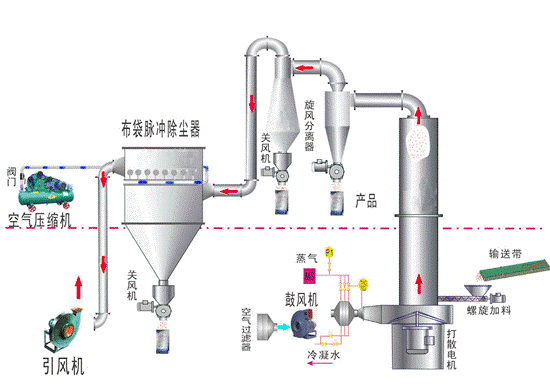There is an inverted cone drying chamber at the bottom of the rotary flash dryer, a vertical stirring device is installed in the middle, a tangential air inlet is arranged on the side of the rotary flash dryer, and an extension device and a discharge port are arranged on the top. After the material enters the rotary flash dryer, under the action of the rotating hot air and agitator, a mixed fluidized bed of large and small particles is formed in the cone-shaped cavity. The large particles are continuously crushed, and the fine particles that have lost part of the water are suspended in the airflow spiral Ascending, the qualified products with moisture and particles are discharged out of the machine through the classification, and the unqualified products are returned to the vulcanization zone to continue to be crushed and dried until all the products are discharged.
Features:
Rotary flash dryer is a drying equipment that integrates drying technology and fluidization technology. Compared with traditional dryers, the rotating flash dryer technology is more advanced, which strengthens the gas-solid heat transfer effect, greatly shortens the drying time, and greatly improves the product output and quality. It overcomes the high energy consumption of drying equipment and fluidized bed The shortcomings of uneven drying, combining the advantages of both, become an ideal drying equipment with the characteristics of high efficiency, energy saving, and speed. The rotary flash dryer is suitable for the direct drying of pastes, filter cakes and other materials. It makes up for the low efficiency and low output of rake drying. It also changes the complicated process of spray drying before dilution and spray treatment. At present, it is widely used in the drying of high viscosity, high consistency and mature sensitive paste materials in the chemical industry such as light industry, petroleum, chemical fiber, food, mining, coatings, dyes and intermediates.
Specification model:
Note: 1. The amount of water evaporation is the water that evaporates per hour when the inlet air temperature is 180°C and the outlet air temperature is 80°C.
2. In addition to the above models, users make special designs.
3. The above installed capacity is a standard package, and the power package can be significantly reduced according to different materials.
Process flow:
Equipment in kind:











